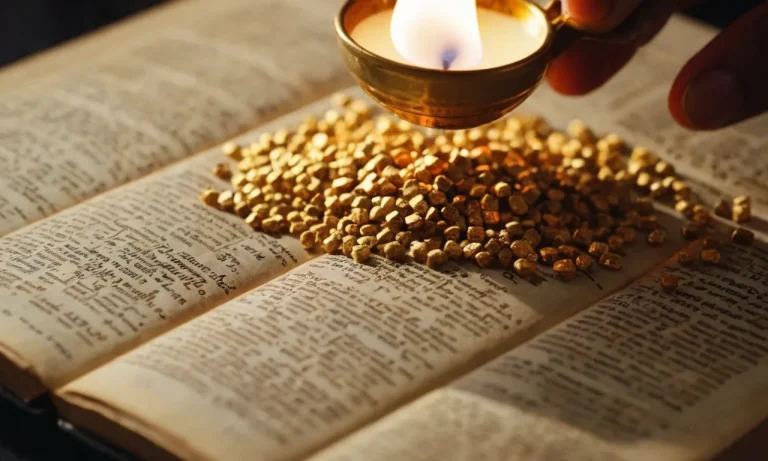Flowers have held symbolic meaning since ancient times. Their beauty, fragrance, and variety have given them a special place in mythology and spirituality across cultures. For Christians, several flowers and plants hold special meaning from their mention in the Bible.
If you’re short on time, here’s a quick answer to your question: roses represent love, lilies symbolize purity and resurrection, the mustard seed reflects the power of faith, and the palm branch signifies victory and peace.
In this comprehensive guide, we will explore the deeper spiritual meaning behind 5 different flowers and plants found in the Bible and how they reflect Christian themes and beliefs.
Roses and Love
Roses have long been symbols of love and romance in human culture. In the Bible, roses represent the love between God and his people, as well as Christ’s sacrificial love for the church.
In the Old Testament, the rose in the valley is used as a metaphor for God’s love and care for Israel. As Isaiah 35:1 states, “The wilderness and the solitary place shall be glad for them; and the desert shall rejoice, and blossom as the rose.”
This passage points to the abundant blessings of God’s love, which can cause even barren places to bloom beautifully.
The New Testament also uses rose imagery to convey spiritual truths about love. The Song of Solomon frequently mentions roses, lilies, and spice fragrances to describe the deep intimacy and mutual delight between two lovers.
Many scholars see this as a picture of Christ’s affection for his bride, the church.
In particular, Song of Solomon 2:1 says, “I am the rose of Sharon, and the lily of the valleys.” The “rose of Sharon” refers to a fertile plain on the coastal region of Israel. This poetic passage symbolizes the community of believers flourishing in the loving care of their Savior, a rose blossoming in the valley.
Roses Overcoming Hardship
An additional spiritual meaning connected to roses in the Bible is overcoming hardship. Just as a rose thrives despite having thorns, believers can experience divine joy and beauty amidst trials. In Ecclesiastes 3:1, King Solomon wrote, “To every thing there is a season…a time to weep, and a time to laugh.”
The apostle Paul also embraced paradoxes, saying he had learned “the secret of facing plenty and hunger, abundance and need” through God who strengthened him (Philippians 4:12-13). As 2 Corinthians 2:14 promises, it is Christ who “leads us as captives in his triumphal procession.”
Therefore, no matter our struggles, we are more than conquerors through his love. Just as a rose releases fragrance even when crushed, the believer’s life can shine with grace and truth in distressed times.
The Eternal Love of Christ
Finally, roses remind us of Jesus’ willingness to be broken on our behalf. Isaiah 53:5 prophesies that Christ would be “pierced for our transgressions” and “crushed for our iniquities.” As the saying goes, “Every rose has its thorns,” except when it comes to Christ’s love which has no limits and expects nothing in return.
The red rose also hints at Christ’s shed blood to attain victory over sin and death. Romans 5:8 attests, “But God demonstrates His own love toward us, in that while we were still sinners, Christ died for us.”
Truly, such sacrificial and unconditional affection is the epitome of the romantic sentiment behind giving a dozen red roses.
Just as a rose’s loveliness outlasts its season, the Bible reminds believers that “love never fails” (1 Corinthians 13:8). Through faith in Christ, our own frail existence is swallowed up by divine eternity as “the world is passing away, and the lust of it; but he who does the will of God abides forever” (1 John 2:17).
It is this enduring spiritual love between Creator and creation that the rose elegantly embodies.
Lilies and Purity
In the Bible, lilies are a symbol of purity and holiness. This beautiful flower is mentioned several times in Scripture in reference to its white color and without ornamentation, symbolizing the simplicity and perfection of Christ and the Christian life.
One of the most well-known Biblical references to lilies is in Matthew 6:28-29, when Jesus tells his followers to “Consider the lilies of the field, how they grow: they neither toil nor spin, yet I tell you, even Solomon in all his glory was not arrayed like one of these.”
Jesus uses the lily as an object lesson – if God clothes simple flowers so beautifully, how much more will He clothe His children whom He loves. The splendor and purity of lilies is contrasted with the temporary glory of even the richest human king.
This theme of purity associated with lilies is echoed in Song of Songs, where the Lover describes his Beloved: “Your two breasts are like two fawns, twins of a gazelle… Your stature is like a palm tree, and your breasts like its clusters. I say I will climb the palm tree and lay hold of its fruit.
Oh may your breasts be like clusters of the vine, and the scent of your breath like apples, and your mouth like the best wine” (Song of Songs 7:3, 7-9). Here, the Beloved’s purity and beauty is compared to a palm tree, vine, apples, and lilies (“breasts like clusters”).
The color white in the Bible generally represents righteousness, holiness, and purity. As BibleStudyTools notes, the white lily symbolized chastity and virtue – “attributes esteemed so highly by the early Christians.”
The lily’s white color and trumpet shape represented the spiritual purity, righteousness, and life God offers His followers through faith in Jesus Christ.
Jesus as the Lily of the Valley
One of the names given prophetically to the coming Messiah in the Old Testament is “the Lily of the Valley” found in Song of Songs 2:1 – “I am the rose of Sharon, the lily of the valleys.” Sharon was a fertile plain in Israel famous for its blossoms, especially roses.
Here, the Beloved is the promised Messiah who will arise from the “valleys” or lowly places.
This points to Jesus’ later birth in a lowly manger and ministry to the poor and outcast of society. Though born in humble surroundings, the Messiah would possess pure royal beauty and glory. As the Holman Bible Dictionary notes, the majestic white lily blooming in lowly places was a striking picture of Christ’s holiness bringing beauty among the common people captive in sin.
The lily visually represented the paradox of the Messiah’s glory stooping down in mercy.
Jesus exhibited princely purity and power while ministering in the most rugged wilderness and slums – the “valleys” of human existence. The lily of Song of Songs paints a prophetic picture of Jesus leaving heaven’s glory, entering the dark valleys afflicted by sin and death, and transforming lives by His sinless beauty. As 1 Corinthians 15:22 states, “For as in Adam all die, so in Christ all will be made alive.”
| Lily Imagery | Meaning |
|---|---|
| White color | Purity, righteousness, holiness |
| Without ornamentation | Simplicity, perfection |
| Fragrant scent | Sweetness, beauty |
| Blooming in lowly valleys | Messiah’s incarnation and mercy |
Mustard Seed and Faith
In the Bible, the mustard seed is used by Jesus in a famous parable to illustrate the power of faith and how something small can grow into something great. Jesus preached, “With what can we compare the kingdom of God, or what parable shall we use for it?
It is like a grain of mustard seed, which, when sown on the ground, is the smallest of all the seeds on earth.”
The mustard seed is one of the smallest seeds found in the ancient world, but it grows into a shrub larger than other shrubs with branches where birds can nest. This shows how a tiny bit of faith can blossom into something magnificent and life-giving when nurtured and nourished.
In the spiritual context, the tiny mustard seed represents the start of one’s faith journey. When we first take baby steps and sow the initial seeds of faith in God, even if it feels small and insignificant at first, that faith can flourish and spread like the rapid growth of a mustard shrub when tended properly.
Through dedicated spiritual practices like prayer, meditation, or acts of service for others, our initial sprout of faith grows stronger and firmer day by day. What starts as a sapling faith transforms into a well-rooted faith that uplifts and blesses many others just as mustard shrubs become the safe shelter for birds.
As Christians, we can always look to the mustard seed parable when our faith wavers. It reminds us to nurture even the tiniest glimmer of faith within us, confident that God can perform miracles and turn it into an abundant faith that guides us through life’s storms. A faith that moves mountains!
Palm Branch and Victory
The palm branch holds deep spiritual meaning in the Bible as a symbol of victory, honor, celebration, and eternal peace. When Jesus entered Jerusalem before his crucifixion, people welcomed him by waving palm branches and covering his path with them (John 12:13).
This act gave Jesus the honor of a king and represented the people’s expectation that he would defeat Roman rule. The palm branch recalled the triumphant entry of Simon Maccabeus into Jerusalem over a century earlier when people celebrated with music and palm fronds (1 Maccabees 13:51).
In the Bible, the palm tree represents vitality, fertility, and victory. The psalmist uses palm tree imagery when praying that the righteous will flourish like a palm tree (Psalm 92:12). At the Feast of Tabernacles, the Israelites constructed booths from palm branches to remember God’s protection during their wilderness journey (Leviticus 23:40).
The palm tree’s ability to thrive in arid climates made it a symbol of tenacity and God’s providence.
When the great multitude from every nation waves palm branches in Revelation 7:9, it signifies their final victory through faith in God and the Lamb. Their white robes point to purification from sin, and their palm branches acknowledge God as the source of their salvation.
This scene offers a glimpse of the eternal peace believers will experience with God.
Besides representing triumph and vitality, palm branches also symbolize joy and celebration. When Jesus told the parable of the prodigal son, the father ordered the fattened calf to be killed so they could celebrate with feasting (Luke 15:22-24).
Their banquet would have included music and dancing with palm branches. The palm expressed jubilation at the son’s return.
Throughout history, images of palm branches have adorned coins, art, architectures, and flags. The palm endures as a universal symbol of honor, victory, celebration, and eternal reward for remaining spiritually steadfast.
Just as palm trees can survive harsh desert storms, the faithful can endure life’s trials through God’s providence. The Bible reminds believers that, like the great multitude’s palm branches, their faith has led them to eternal victory.
Cedar Tree and Healing
Cedar trees hold special meaning in the Bible and are associated with purification, healing, and protection. The hardy evergreen cedar spoke to ancient people of strength, longevity, and God’s power of renewal.
Scriptures identify the cedar as a tree of life and temple building, connecting the majestic tree to spiritual concepts of resurrection and the presence of God.
Purification Properties
With its aromatic oil and rot-resistant wood, the cedar tree has long symbolized cleansing and purification. In Leviticus 14, God instructs the Israelites to use the cedar wood in cleansing rituals for skin diseases. This established the tree’s enduring link to purification powers.
Later, David and Solomon used great cedar beams to build God’s temple in Jerusalem (1 Kings 6,7). Biblical writers saw the cedar forests of Lebanon as God’s provision for this holy work. The temple was God’s earthly home, needing purification elements like cedar wood.
Healing Attributes
Beyond purification rites, the Bible also connects cedars to healing. Psalm 92:12 says the righteous will grow like a cedar in Lebanon. The verse hints at the vitality and healing properties credited to cedars through biblical times.
Ancient cultures looked to the cedar’s oils to treat inflammation and infection. Growing like a cedar meant thriving in righteousness and health.
Ezekiel 31:1-18 also tells a parable of Egypt as a fallen cedar of Lebanon. Though once majestic like the great cedars, Egypt lost status by opposing God. However, verse 15 notes that after destruction “the cedar shall revive and grow fresh twigs.
“ This affirms the cedar’s connection to healing, suggesting that these evergreens can renew life even after ruin.
Divine Protection
The Bible lastly associates the cedar with safety in God’s care. Numerous verses describe God’s ideal world as one where people would live in peace and prosperity under their own cedar trees (1 Kings 4:25, Micah 4:4). Likewise, Hosea connects cedar wood panels with safety in houses (Hosea 8:14).
The cedar tree offered both physical protection and symbolic refuge under God’s wing. Psalm 104 even pictures God watering the cedars of Lebanon – showing divine care over these special trees.
With associations of cleansing, healing, and blessing, the cedar tree wove an inspirational message through Scripture. Its wood built sacred spaces for God’s presence. Its boughs reached out as a marker of health and life. And its aromatic oils inaugurated purification rituals among God’s people.
Truly, the hardy cedar played an integral role in revealing God’s restoring powers.
Conclusion
Throughout history, flowers have been powerful symbols representing our deepest beliefs. As illustrated through their mention in the Bible, roses, lilies, mustard seeds, palm branches, and cedar trees reflect core Christian themes of love, purity, faith, victory, and healing.
The next time you encounter one of these plants or flowers, reflect on its deeper spiritual meaning and how it calls you to embody these virtues in your own life.






